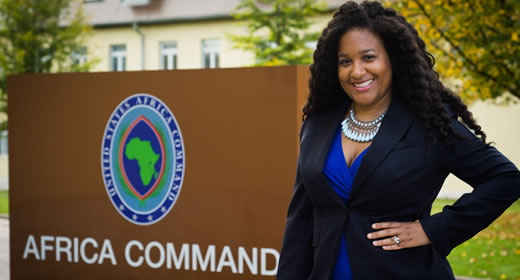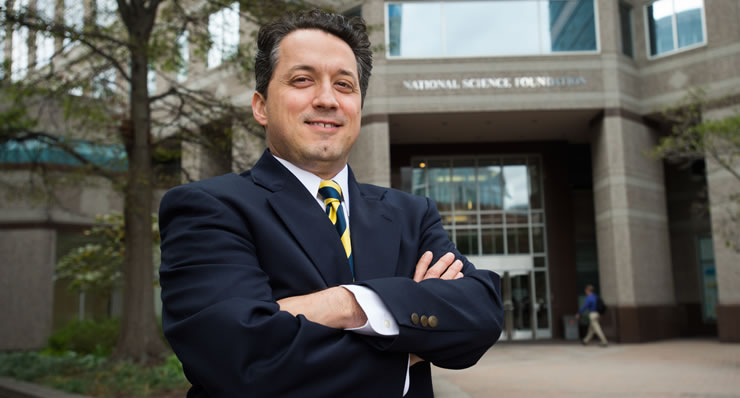
By Erin Spanier
In the 1950s, a half-dozen African nations had won their independence. In 1960, more than a dozen others followed. It wasn’t long before these new nation-states would send their top diplomats to Washington, DC to present their credentials. But traveling south on Route 40 from New York to the capital, they’d quickly experience U.S. segregation at hotels and restaurants along the way.
“And they were told, I’m sorry, we don’t have your kind here,” reports Berl Bernhard, director of the U.S. Commission on Civil Rights at the time, in a Backstory episode marking the 50th anniversary of the Civil Rights Act of 1964.
The momentum for civil rights was building across the nation, but in the midst of the Cold War, says Ed Ayers, host of Backstory, “these accounts of a two tiered society were grist for the Soviet propaganda mill.” It was in this climate that the U.S. Department of State hired Jean Drew Lightfoot (MPA ’50) as a public information specialist in 1962.
Lightfoot was eminently qualified for the post. She had a master’s in public administration and considerable experience in public relations—for Howard University, for the Coca-Cola Company, and for the Community Relations Conference of Southern California—and must have quickly taken to the work of organizing foreign policy conferences and acting as a liaison for nongovernmental organizations. Just four years later, in 1966, Jet Magazine would describe her as one of the top African American women in the U.S. Department of State.
Still, and in spite of her qualifications, some might argue that it was the country’s pragmatic interest in African independence that opened a path for Lightfoot at the State Department; so it’s interesting to note that supporting African nations is part of the work of a more recent Ford School alum, Marissa Rollens (MPP ’07).
Rollens, a foreign service officer for the U.S. Department of State, is currently assigned as a foreign policy advisor (POLAD) to AFRICOM, which works to support U.S. interests by building the defense capabilities of African nations and helping them respond to crisis.
Some of that work is done through training exercises with African military units. Some of that work is done through institution building, like a women’s peace and security conference to talk about how militaries can ensure the safety of women and children in conflict areas, and can recruit, retain and promote women in their ranks.
The key focus, says Rollens, is shared interests and cooperative engagement. “It’s not a U.S. go in there and say what’s right and what’s wrong, but really working with the countries to secure a better future.” Toward that end, Rollens, who hurriedly admits she’s a relative novice to military operations, offers guidance on how to work diplomatically, collaboratively, and sensitively in the region.
In recent weeks, AFRICOM’s support of shared interests is looking a lot more like humanitarian aid than military defense. Through Operation UNITED ASSISTANCE, the command center is now delivering and constructing a number of urgently needed field hospitals for the treatment of West African Ebola victims. (At time of press, 18 field hospitals had been pledged). Rollens, who has learned a good bit about military capabilities since the start of her assignment, notes that some military strengths—engineering, logistics—may prove immensely helpful in a multifaceted, multinational Ebola response.
In the same year that the Academy Award-winning Mr. Smith Goes to Washington was released, President Franklin D. Roosevelt lured the Ford School’s own Mr. Smith to Washington, DC to serve as director of the U.S. Bureau of the Budget. Roosevelt had transferred the Bureau of the Budget from the Treasury Department to the Executive Office of the President, and needed someone to run it. Harold D. Smith (MPA ’25) caught his eye.
At the time, Smith was serving as budget director for Michigan. Earlier, he’d been the first director of the Michigan Municipal League, and director of the Ford School’s own Bureau of Government Research. When he got to Washington, his responsibilities expanded by orders of magnitude.
Before the Bureau of the Budget, every government agency had applied to Congress directly for its yearly appropriation. The bureau was meant to oversee that process. After all, wrote a journalist for TIME magazine in the summer of 1943, “Government agencies do 10,001 jobs, from building battleships to advising farmers about the pink bollworm. But they all do one thing in common: spend money.”
The title of that article, featured on the cover of the 15-cent edition, “Harold D. Smith, Director of the Budget.” The subtitle: “Czars may come and czars may go, but he goes on forever.”
As the size and complexity of government has grown, public sector budget professionals are working as hard as ever to do the same sorts of things Smith did—to secure funding for U.S. interests, to make sure those investments yield returns, and to stretch government dollars.

For Antony DiGiovanni (AB ’95, MPP ‘00), who’s just started a post as deputy budget director of the National Science Foundation, all of that’s a given. He’s more interested in the mission of the organizations he serves, and the innovative budgeting models that can be employed to achieve it.
DiGiovanni spent the last 14 years working in the field of federal budget and appropriations, most recently directing the budget office of the U.S. Department of Energy’s Advanced Research Projects Agency–Energy (ARPA-E). As the second person hired at ARPA-E in 2009, he saw it through the startup phase.
While other agencies were trying to make incremental progress in the cost, efficiency, and longevity of existing technologies, ARPA-E’s mission was to displace the prevailing technology, he says, to leapfrog it.
To do that, they needed a new budgeting model—one that would allow them to quickly respond to high-risk, high-reward energy breakthroughs the private sector was bypassing. While most agencies, including NSF, need to prepare budget requests 18 months in advance of the work they want to do, DiGiovanni and his colleagues made a compelling case for a more nimble model, and ultimately won congressional support.
Below is a formatted version of this article from State & Hill, the magazine of the Ford School. View the entire Fall 2014 State & Hill here.
